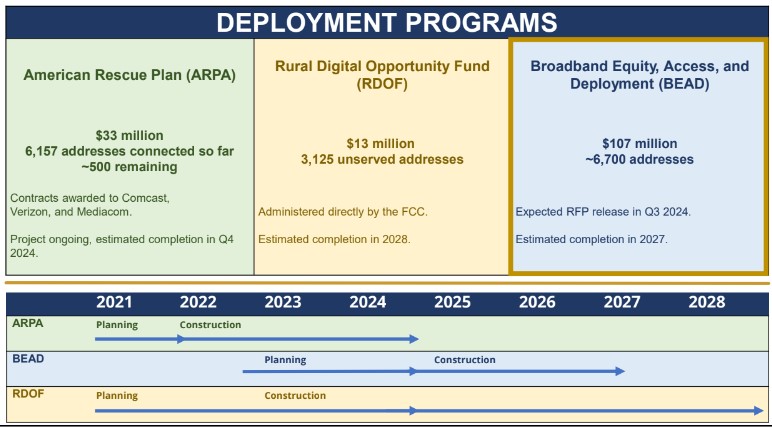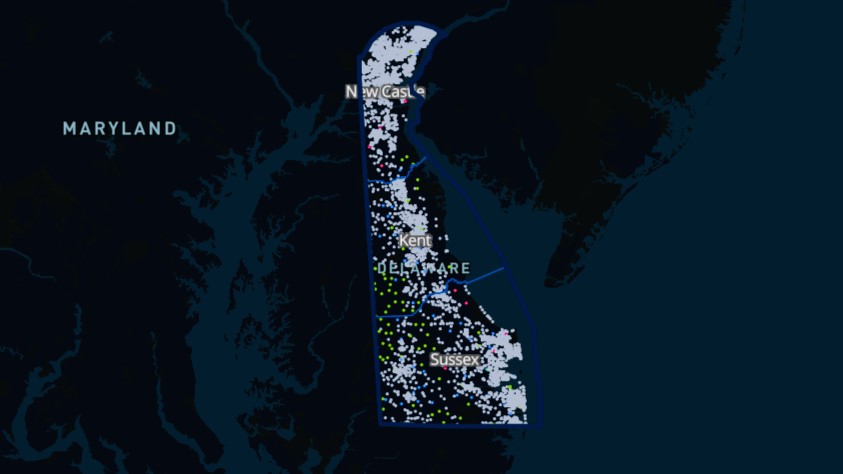The Digital Equity Plan was developed over months of stakeholder engagement, public meetings, surveys, polls and a public comment period. Delaware now expects to receive about $12 million in federal Digital Equity Act funds under the Internet for All initiative. The state will eventually grant funds to various entities, ranging from internet service providers (ISPs) to workforce development programs, to make the plan a reality.
Delaware is the second state, after Louisiana, to receive equity plan approval. It’s anticipated to be the first state in the US to achieve 100% high-speed broadband access, which includes infrastructure, accessibility and affordability.
Read the plan in English, Spanish or Haitian Creole
What’s next?
Delaware Broadband Office Executive Director Roddy Flynn held a virtual town hall on Wednesday evening to discuss the process’ immediate future.
There are two main focus areas:
- Deployment, the work of building out high-speed internet infrastructure to every address in Delaware“What internet means is enough internet that a home could have multiple people on laptops or tablets, streaming video, doing telework, doing remote learning — what you really need when it comes to full access to high-speed internet in 2024,” Flynn said. “That’s the floor that we’re going to bring everyone up to. If you are below that level, you’re considered unserved for Delaware.”For community institutions such as libraries, the minimum speed will be one gigabyte per second.
-

The schedule of broadband deployment. (Screenshot)
-
- Digital Equity, the work of bringing internet to every person in Delaware, regardless of address, income, age or disability.“In the digital equity space, we ask, ‘Is the internet affordable for everyone?’” Flynn said. “We also ask questions about our tech jobs, digital jobs, 21st-century jobs available to everyone in Delaware, do we need to grow workforce programs in order to make sure that we’re ready for the economy of tomorrow?”Digital equity also means that every resident has a digital device such as a laptop, and that all inhabitants with disabilities have accessibility needs met.
Flynn discussed other key points, distilled into these five takeaways:
1. Time is running out to identify digitally unserved addresses
While Flynn said the vast majority — more than 99% — of addresses have been identified as either served or scheduled to be upgraded, there may still be isolated, underserved addresses. The deadline for the final list of addresses requiring service is April 22, so if you have internet service that doesn’t meet the criteria above, contact the broadband office at broadband@delaware.gov as soon as possible.
To see if your address is already part of the plan, check out the interactive Delaware Broadband, Equity, Access and Deployment (BEAD) map.
2. Digital literacy and skills will be a priority
Physical access to the internet only matters if people know how to use it. Kim Siegel, digital equity manager for the Delaware Broadband Office, spoke about making sure residents have baseline skills, including online banking, use of social media, use of email, knowing how to access state resources, internet safety, protecting oneself from scams and identity theft, and telehealth.
3. Long-term sustainability is important
The initial anticipated $12 million investment will be spread over five years, so sustainability will be a major factor.
“We’re going to be looking for what we can get started that will keep going and get more value out of that initial $12 million investment,” Siegel said.
4. Data tracking will help with workforce development
Part of the plan involves workforce development in internet-related jobs, including cybersecurity. Examining trends will help understand where workers are needed. For example, if a bank sees an increase in hacking and needs to hire more cyber professionals, workforce development programming will train people for these positions, resulting in more jobs and more security.
5. ISPs awarded grants for infrastructure or services will be required to have a $ 30-per-month price point for high-speed internet
Base plans in the past have not always met the base criteria the Delaware Broadband Initiative has set, where it must be able to handle multiple users at once and be suitable for both work and school. Once the plan is established, you shouldn’t have to worry that the base level won’t be enough.
Before you go...
Please consider supporting Technical.ly to keep our independent journalism strong. Unlike most business-focused media outlets, we don’t have a paywall. Instead, we count on your personal and organizational support.
Join our growing Slack community
Join 5,000 tech professionals and entrepreneurs in our community Slack today!




